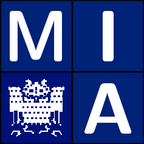
Mathematical Morphology
Home
About Us
People
Teaching
Research
Publications
Awards
Links
Contact
Internal
Mathematical morphology originated from the study of porous media in the mid-sixties. Since then it has undergone a tremendous development resulting in efficient tools for modern image processing and analysis. Morphological operators are successfully used to tackle tasks such as image filtering, image segmentation and classification, texture analysis and pattern recognition in areas ranging from life sciences to material sciences.
The research efforts in our group are currently proceeding in two directions; we are investigating the relation between the well established concepts of morphological and linear scale spaces, and we are developing morphological concepts for matrix-valued data.
- Explaining the Logarithmic Relation between Linear and
Morphological Systems
In 1994 Dorst/van den Boomgaard and Maragos introduced the slope transform as the morphological equivalent of the Fourier transform. As a result an almost logarithmic connection between linear and morphological systems became apparent. In [1],[2] we give an explanation for this relation by revealing that morphology, in essence, is linear systems theory based on the (max,+)-algebra resp. the (min,+)-algebra. The fundamental operations of dilation and erosion turn out to be convolutions with respect to these algebras. The so-called Cramer transform as the conjugate of the logarithmic Laplace transform establishes a homeomorphism between morphological and Gaussian scale space. These articles provide a step towards the unification of linear and morphological scale-space theory on the basis of a linear systems theory in an appropriate algebra. -
Families of Morphological Scale Spaces
In [3] morphological dilation and erosion scale spaces with parabolic structuring functions are embedded into two-parameter families of scale spaces which include the Gaussian scale space as a limit case. The scale space families are obtained by deforming the algebraic operations underlying the morphological operations. Aspects of these scale space families such as continuity, invariance and separability are discussed. The article enriches the picture of structural analogies between the classes of scale spaces mentioned above.
The processing of matrix-valued data sets (so-called tensor fields)
is becoming an increasingly important task in modern digital imaging
since the tensor concept provides an adequate description of anisotropic
behaviour: Prominent examples are the diffusive behaviour of water molecules
in tissue, visualised by diffusion tensor magnetic resonance imaging (DT-MRI),
or the so-called structure tensor used in fields ranging from motion
analysis to texture segmentation.
Our group has developed morphological operators for tensor-valued
images (interested readers should refer to our web site on
tensor fields):
-
Tensor-Valued Morphology
Morphological operations are based on dilation and erosion which in turn rely on maximum and minimum operations. Their generalisation to the tensor-valued setting is not straightforward due to the lack of suitable ordering relations for symmetric matrices. In [4] we have proposed such extensions exploiting analytic-algebraic and geometric properties of symmetric matrices while preserving positive definiteness of the initial data.
-
B. Burgeth, J. Weickert:
An Explanation for the Logarithmic Connection between Linear and Morphological Systems.
In L.D. Griffin, M Lillholm (Eds.): Scale Space Methods in Computer Vision. Lecture Notes in Computer Science, Vol. 2695, Springer, Berlin, 325-339, 2003.
-
B. Burgeth, J. Weickert:
An Explanation for the Logarithmic Connection between Linear and Morphological System Theory.
Preprint no. 95, Department of Mathematics, Saarland University, Saarbrücken, Germany, 2004.
Slightly extended version of the conference paper above.
-
M. Welk:
Families of Generalised Morphological Scale Spaces.
In L.D. Griffin, M Lillholm (Eds.): Scale Space Methods in Computer Vision. Lecture Notes in Computer Science, Vol. 2695, Springer, Berlin, 770-784, 2003.
-
B. Burgeth, M. Welk, C. Feddern, J. Weickert:
Morphological operations on matrix-valued images.
In T. Pajdla, J. Matas, V. Hlavac (Eds.): Computer Vision - ECCV 2004. Lecture Notes in Computer Science, Springer, Berlin, 2004, in press.
MIA Group
©2001-2005
The author is not
responsible for
the content of
external pages.